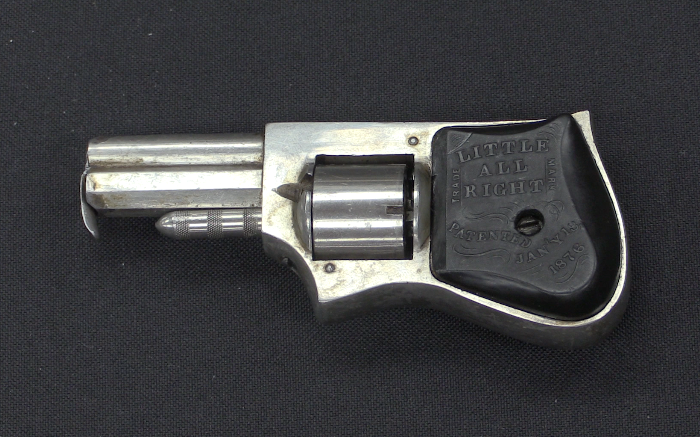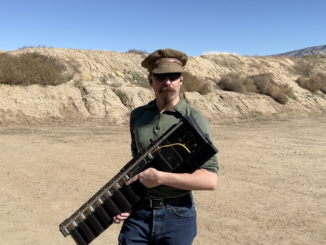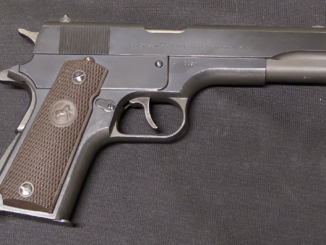After extended testing in 1913 and 1914, the US formally adopted the Vickers gun as the Model 1915. A contract was placed for licensed production of 125 guns by Colt, who had also taken contracts to produce Vickers guns for the UK and Russia. It would ultimately be the summer of 1917 before the first guns arrived for US Army use, and a total of 12,125 were made by the time production ended in September 1918 (in favor of the new Browning 1917 machine gun). Ten divisions of the American Expeditionary Force were equipped with Colt Vickers guns in .30-06 in World War One, and they gave good service on the battlefield. The are very scarce today because almost all surviving examples were sent to Britain as part of Lend-Lease in World War Two, and destroyed at the end of that conflict.
Related Articles

Revolver
RIA: Little All Right
Aren’t these 19th century little pocket pistols cute? This is another palm-type hideout gun, named the “Little All Right” and patented in 1876. It’s actually a pretty basic revolver mechanism, just put into an unusual […]

Competition
I Tried to Use the GR-1 Anvil at the BUG Match…
So, I took the GR-1 to this month’s Backup Gun Match…but all did not go as I’d hoped. We blew a fuse in the gun (it is still an alpha prototype, remember), and were not […]

Prototype
Colt Prototype Double Action 1911
Thanks to Legacy Collectibles, today we have a unique Colt prototype pistol to look at today – a double-action variation of the 1911. Judging by the grips and markings, this was made in the late […]

Stupid question: Did Colt also make .50 caliber Vickers guns?
If you mean the .50 BMG, the first prototype cartridges didn’t exist until the very day WWI ended. So any use would have needed to be inter-war, but was the Vickers ever chambered for anything with an OAL >3.34in, or caliber larger than 11×59mmR Gras?
The Vickers .50 calibre machine gun was only made around WWII and was chambered for the British 50 calibre cartridge which was entirely different to the US 50 calibre cartridge. These Vickers guns were used primarily by the Royal Navy and later in WWII by merchant ships. These guns are very rare as most were scrapped after WWII. The Australian War Memorial has one in storage which came from New Zealand.
Thanks for the lead. The .50 Vickers (12.7×81mm) looks like it might have had an OAL that minimized the changes needed to feed it.
i have sitting in my gun safe for sale or trade its a live gun in auckland and new zealand
It’s a bit strange…
I thought that USA Maxim MG had a slightly different muzzle…
https://www.morphyauctions.com/jamesdjulia/item/1007-369/
https://www.morphyauctions.com/jamesdjulia/item/1006-369/
US consumer prices in 1915: Pork chops, 12c./lb.; eggs 27c./dozen; rice 4c./lb.
I have a vague memory that a Browning A5 cost $25; an Iver Johnson revolver about three bucks. I found a listing for a Hopkins & Allen solid-frame, advertised in 1909, for $2.75.
Up to 1934 $20.67 were worth troy ounce of gold, according to https://goldprice.org/gold-price.html current price for troy ounce is USD1,746.36, so by multiplying by 85 you might estimate price in today USD.
But that’s ridiculous because you would also have to multiply wages by 85 to determine what money people actually had available to buy things. I’m sure the Ford workers who were making $5 a day at that time did not live like people making $425 a day nowadays.
Also, we’ve had periods of time where there was no change in gold prices, but wages fluctuated wildly (the WW1 period being an example) and other periods where gold prices fluctuated wildly but wages remained depressingly stagnant (like today).
I can appreciate an inflated price for a beginning run. But what price did Colt get AFTER the first 125? What did they charge the Russians and British? And who in U.S. procurement negotiated such a terrible deal?
If this is true, royalties from each machine gun manufactured in Russia was 80 British pounds in gold for 10 years.
That was almost exactly three times less than the price for direct purchase.
https://booksonline.com.ua/view.php?book=88400&page=9
I had ‘heard’ (from various unverifiable written and oral sources) that US Vickers supply were insufficient and that the US divisions depended heavily on British parts-whole guns (in quantity). Though if this was true or a myth I have been unable to determine.
It sounds a little strange…
The United States, on the contrary, supplied the Entente with weapons.
The USA itself used Maxim machine guns only for training, but not in combat.
Perhaps this was referring to the 37mm Maxim-Nordenfelt guns used in the NAVY?
http://www.navtechlife.com/Automatic%20guns_Vickers%20Maxim.htm
The British painted a red line on Lend Lease weapons that resembled British weapons (M1915, M1917 rifle, etc) so everyone knew they were chambered for 30-06 instead of 303.
As far as the British offering them back at the end of the war, they were required to do so by the Lend Lease Act. Items provided under its provisions remained US property and had to be either returned or paid for after the war was over. In practice, there were many items the US didn’t want back and as they were also not wanted by Britain. the two countries agreed to destroy these and forego the payments.